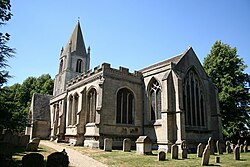| St John the Baptist, Barnack | |
|---|---|
 St John the Baptist's Church, Barnack | |
| 52°37′57″N0°24′25″W / 52.6326°N 0.407°W | |
| Location | Barnack, Cambridgeshire |
| Country | England |
| Denomination | Church of England |
| Churchmanship | Broad |
| Website | https://parishnews-online.co.uk/st-john-the-baptist-church-barnack/ |
| History | |
| Dedication | John the Baptist |
| Architecture | |
| Functional status | Active |
| Heritage designation | Grade I |
| Designated | 19 March 1962 |
| Specifications | |
| Spire height | 114 feet (35 metres) |
| Administration | |
| Province | Canterbury |
| Diocese | Peterborough |
| Archdeaconry | Oakham |
| Deanery | Peterborough |
| Parish | Barnack with Ufford |
| Clergy | |
| Rector | Reverend Gary Alderson |
The Church of St John the Baptist, Barnack is a Church of England parish church in the village of Barnack, now in the City of Peterborough unitary authority area of the ceremonial county of Cambridgeshire, England.






